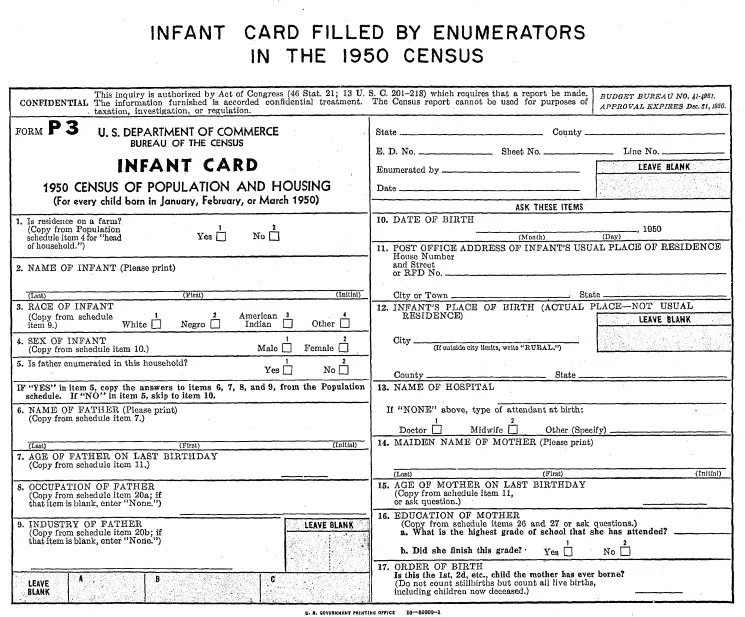Why 2022 Promises to be a Banner Year for Genealogy Research!
Anyone who has even dabbled in genealogy research has probably used them. They help define relationships, provide detailed information to help reconstruct our ancestors’ lives -- and give even more clues about where to look next. Many research sites make them available to researchers and often for free. Unfortunately only recorded incrementally instead of annually, they are nevertheless the backbone of most genealogy research projects. You probably already know that I am referring to those beautiful, old (if sometimes frustrating) CENSUS RECORDS!
In 2022, at least two new censuses will be made public record, and genealogists are already chomping at the bit. Perhaps this is the key we need to unlock our most intriguing genealogical mysteries!
First, if you have English or Welsh Ancestry, TODAY marks the release of the 1921 Census for England and Wales.[1]
The 1921 Census for England and Wales looks particularly valuable for researchers due to the detailed questions asked of each household. These include:
· Name and Surname
· Relationship to Head of Household
· Age (In years and months)
· Sex
· Marriage or Orphanhood
· Birthplace
· Nationality
· If Attending School
· Personal Occupation
· Employment
· Place of Work
This is the most detailed census record for England and Wales thus far.[2] Perhaps most interestingly, this is the last census for England and Wales that will be released to the public until the 1951 Census is released in 2052!![3]
You can find these records today at FindMyPast.co.uk. The company has been busy digitizing the records over the past three years![4] They are already searchable by name.
Across the pond here in the US, researchers are patiently (or impatiently) waiting for the 1950 US Federal Census which promises to be released in April![5]
Image from United States Census Bureau
Much like the 1940 Census, the 1950 Census asked similar questions about relationships, origins and occupations. Differences between the two are detailed here.
However, the 1950 census is particularly alluring in a couple of ways:
· For the first time ever, the 1950 census enumerated Americans living abroad.[6] This is hugely advantageous should you have family serving overseas with the military or working onboard a ship, for example.
· The 1950 Census also asked a specific question about whether any household member may have been missed due to travel or other factors.[7] Don’t we all wish that question was included on previous censuses?
· This will be the first census to enumerate some members of the Baby Boomer generation.
· Children born in January, February or March 1950 were enumerated on special “Infant Cards” which asked for quite detailed information.[8] Given this census took place during the “Baby Boom,” I imagine there were a lot of infant cards recorded!
As the adage goes, “a watched pot never boils” so -- what can we do in the meantime while we wait for this gem to be released and indexed? Lots of things actually!
1. Define and prioritize our research questions. What are we most hoping to learn from the census and who do we need to find first to help answer those questions? As we all know, distractions come at as quickly when we are researching. By writing down our most important research questions we are better able to discern which paths are worth following immediately and which ones need to go on our “backburner” spreadsheet.
2 Find your ancestors’ locations and enumeration districts. Because it will take sometime for the record to be indexed, upon this census’ immediate release we will NOT be able to search for individuals by name. Rather, we will need to use their location (if known) to BROWSE through the pages. Once the indexing is complete, the record will be searchable like always. To better understand how to search by location, head over to Stephen Morse’s website for a detailed explanation and tutorial!
3. Volunteer to help index the 1950 Census – such a great way to give back to the genealogical community (which as we know is a very generous one). Both the National Archives and FamilySearch are accepting volunteers. Find out more here and here.
4. Finally, in preparation for this much anticipated release, we can make sure we are ready to use the information the census provides to the fullest. I absolutely love Judy Russel’s lecture about US Census Records at Legacy Family Tree Webinars. Check it out!
[1] “The 1921 Census, the largest census release ever in England and Wales,” The National Archives (nationalarchives.gov.uk : accessed 6 January 2021), home > 20sPeople > The 1921 Census.
[2] “What’s interesting about the 1921 Census?,” The National Archives (nationalarchives.gov.uk : accessed 6 January 2021), home > 20sPeople > The 1921 Census.
[3] Ibid. These Censuses for England and Wales are sealed for 100 years. The 1931 census does not survive and the 1941 census was never taken due to the Second World War.
[4] Ibid.
[5] “When will records be available?” The United States Census Bureau (census.gov : accessed 6 January 2021), History > FAQs > Genealogy FAQs.
[6] “1950 Overview,” United States Census Bureau (census.gov: accessed 6 January 2022), History > Through the Decades > Overview.
[7] “Are you Ready for the Release of the 1950 Census?” Census Tools (Censustools.com : accessed 6 January 2022), Home > Census Records.
[8] Lisa Cook, “The 1950 Census for Genealogy,” 6 April 1921 Lisa Louise Cook’s Genealogy Gems (LisaLouiseCook.com : accessed 6 January 2021), 01 What’s New > 1950 > Census > Elevenses with Lisa.




